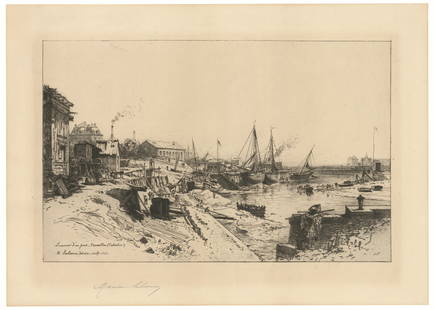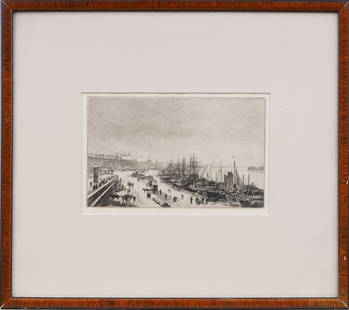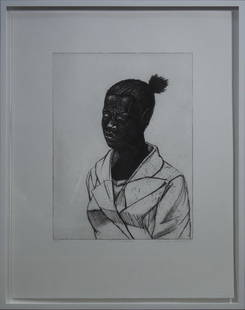
19thc etching of Acacias by Maxime Lalanne
Maxime Lalanne Sale History
View Price Results for Maxime Lalanne
Related Prints & Multiples
More Items from Maxime Lalanne
View MoreRecommended Art
View More







Item Details
Description
19thc etching of Acacias by Maxime Lalanne
Etching (sight to mat): 10.5" x 7.5"
Frame: 19.5" x 15.5"
Maxime Lalanne
(wiki) Francois Antoine Maxime Lalanne (November 27, 1827 - July 29, 1886) was a French artist known for his etchings and charcoal drawings (fusain).
Maxime Lalanne was born in Bordeaux on November 27, 1827, to Anne (previously Anne Cecile Gellibert) and Antoine Lalanne.[1] His father was a civil servant who rose to the position of clerk of the first chamber of the Court of Appeals.
Maxime Lalanne first pursued classical and traditional studies at the l'institution Ore, where he learned drawing from Saulnier. He received his Bachelor of Letters degree in 1848. Although his artistic talent was noted by his comrades and teachers, Lalanne pursued a career in law rather than in art.
In 1852, Lalanne followed their advice and left Bordeaux for Paris and the studio of Jean François Gigoux (with whom Lalanne remained close throughout his life).[12] Lalanne's ties to Bordeaux remained strong: he exhibited 640 works there in a retrospective in 1874 and donated proofs of all his etchings to the city in 1875 and 1882. But regardless of those ties, Lalanne became and remained a Paris artist who lived, worked and taught chiefly in Paris until retiring to Nogent-sur-Marne in 1885.
Lalanne made his appearance at the Salon in Paris in 1852 with two charcoal drawings, which he continued to submit throughout his career. Charcoal had only been recently recognized by the Salon as an independent category, and was very popular for both its novelty and expressiveness. Lalanne's reputation in the medium is evidenced by his well-received treatise on the subject, Le Fusain. The importance of drawing to Lalanne is without doubt-- at his death the number of Lalanne's drawings in public and private hands exceeded 1200.
Lalanne's print debut was in 1853—in lithography rather than etching. Lalanne began etching for Alfred Cadart in 1862 as one of the founding members of Cadart's 160-member Société des Aquafortistes (formed in September 1862), and his work was among the first published and distributed by the Societe-- Rue des Marmousets (published in November 1862 as plate 15). Lalanne made his etching debut at the Salon in 1863, submitting three street scenes (all of which would appear in Cadart publications).
Lalannes etchings struck a chord. He received awards from the Salon for etching in 1866, 1873 (3eme classe), 1874 (3eme classe) and was decorated as Chevalier de la Légion dHonneur in 1875. He was also knighted as Chevalier of the Order of Christ by King Fernando of Portugal (who, perhaps not surprisingly, was one of the 160 members of Cadart's Societe des Aquafortistes).
Lalanne arrived on the scene at an opportune moment, for both himself and for the Cadart publishing house. During the 20-year period in which they worked together (from 1862 to 1881), Lalanne produced over 145 etchings,[26] and the Cadart house issued over 80 of them (often more than once) in numerous Cadart publications.
While the impressionists were rebelling against artistic convention and the Salon, Lalanne remained ever faithful to it, and the Salon accepted and exhibited over 120 etchings by Lalanne from 1863 to 1886. It was because of this loyalty (and the resulting friendships) that Lalanne continued to be a member of the jury of the Salon, for painting, even (according to Marionneau) after illness prevented his full participation.
The recognition of Lalanne's artistic vision has sometimes been crowded out by his self-evident technical skill. His Traité de la gravure a leau-forte instructed generations from its first printing in 1866 through at least 12 editions to 2010. John Taylor Arms, an etcher of peculiar technical attentiveness and intricacy, took his instruction and inspiration from Lalanne. James McBey and Ernest S. Lumsden also taught themselves to etch from Lalannes treatise.
Lalanne taught and demonstrated almost every conceivable technique applicable to the etching plate, but in his own work he remained an almost steadfast adherent to pure line. It is as if anything but pure line was clutter to Lalanne and his worlds. Except for demonstrations, there are no extant examples of pure drypoint in Lalanne's oeuvre. Lalanne saw drypoint as a tool to correct mistakes as explained in his treatise (though he himself sometimes deviated). Although he clearly knew the atmospheric value of aquatint, only one confirmed example of his use of the medium exists-- and only on one quadrant of a plate. Similarly, only one soft ground etching comes down from Lalanne (apart from demonstrations).
Lalanne knew how to command line alone to say precisely what he wanted to say. He accomplished that result through multi-stage biting: a continuing process that created, through line variance, every atmospheric element he desired. The rest was left to (occasional) burnishing, drypoint corrections/additions, and surface tone-- a critical element to Lalanne.
Subjecting plates to numerous progressive bitings, Lalanne achieved a warmth, depth and dimensionality never before seen in etching, and rarely seen since, as a review of some of his work demonstrates. Through multi-stage biting, À Bordeaux drives the viewer from the dark and rich boat and boathouse in the foreground through the harbor to the distant town in a near infinite visual horizon. Through seven identifiable levels of biting, Rade de Bordeaux (Bordeaux, Effet de Neige) creates a blanket of vista that wraps the viewer in a surrounded sense of stillness and snow. In Une Rue de Rouen, the dominance of the cathedral in the background is established not through bold line but through scant biting. In Bords de la Tamise, Lalanne does the near impossible: he creates fog through multi-stage biting alone. Lalanne produced over 200 etchings, but even if had completed only these four, his place in history as a technical genius would have been secured.
Using realistic elements as a vehicle, Lalanne's etchings organize the visual field into a new order of unrelenting harmony, consistent with the subject, that fosters access to the image whose sense of place inspired the work. This would have been branded as a dance too close to the heretical edges of impressionism had it been perceived at the time, but it was not. Critics stumbled close to this reckoning, but never quite reached it.
Lalanne did not use etching to make social, political or even artistic statements, but rather let the world speak for itself. People play only a small role in Lalannes world. Even in Lalanne's volume on Victor Hugo, the author Hugo is no more important than the plants in the garden, and seems crowded and overtaken by them.
Lalanne had his share of failures. Le Rocher de Sisteron, Vittel and Vue des Ruines du Château de Fere, for example, come across as two dimensional amateur exercises with little to commend them. The Crisenoy suite is technically astute but completely vacant, and the same can be said for the six plates that may have been destined for a book on architecture.
Those failures are nevertheless instructive. Against complaints that Lalanne was generally without depth and warmth, these works make it easy to tell when he was, and when he was not. Moreover, they permit us to isolate an additional element of continuity that stretches across all works. At a time when the etching plate was increasing in size, wall display was becoming more pervasive, and the intimacy of etching was at risk, even in his failures Lalanne attempts to draw the viewer closer to establish the connection that is historically fundamental to etching. This continuous predisposition is all the more evident in Lalannes largely unpublished oeuvre of smaller works and miniatures. It is simply impossible to experience most of these works except in close quarters. One of these etchings, Jardin avec statue au bord dune piece deau, is among the best in Lalannes entire oeuvre.
Etching (sight to mat): 10.5" x 7.5"
Frame: 19.5" x 15.5"
Maxime Lalanne
(wiki) Francois Antoine Maxime Lalanne (November 27, 1827 - July 29, 1886) was a French artist known for his etchings and charcoal drawings (fusain).
Maxime Lalanne was born in Bordeaux on November 27, 1827, to Anne (previously Anne Cecile Gellibert) and Antoine Lalanne.[1] His father was a civil servant who rose to the position of clerk of the first chamber of the Court of Appeals.
Maxime Lalanne first pursued classical and traditional studies at the l'institution Ore, where he learned drawing from Saulnier. He received his Bachelor of Letters degree in 1848. Although his artistic talent was noted by his comrades and teachers, Lalanne pursued a career in law rather than in art.
In 1852, Lalanne followed their advice and left Bordeaux for Paris and the studio of Jean François Gigoux (with whom Lalanne remained close throughout his life).[12] Lalanne's ties to Bordeaux remained strong: he exhibited 640 works there in a retrospective in 1874 and donated proofs of all his etchings to the city in 1875 and 1882. But regardless of those ties, Lalanne became and remained a Paris artist who lived, worked and taught chiefly in Paris until retiring to Nogent-sur-Marne in 1885.
Lalanne made his appearance at the Salon in Paris in 1852 with two charcoal drawings, which he continued to submit throughout his career. Charcoal had only been recently recognized by the Salon as an independent category, and was very popular for both its novelty and expressiveness. Lalanne's reputation in the medium is evidenced by his well-received treatise on the subject, Le Fusain. The importance of drawing to Lalanne is without doubt-- at his death the number of Lalanne's drawings in public and private hands exceeded 1200.
Lalanne's print debut was in 1853—in lithography rather than etching. Lalanne began etching for Alfred Cadart in 1862 as one of the founding members of Cadart's 160-member Société des Aquafortistes (formed in September 1862), and his work was among the first published and distributed by the Societe-- Rue des Marmousets (published in November 1862 as plate 15). Lalanne made his etching debut at the Salon in 1863, submitting three street scenes (all of which would appear in Cadart publications).
Lalannes etchings struck a chord. He received awards from the Salon for etching in 1866, 1873 (3eme classe), 1874 (3eme classe) and was decorated as Chevalier de la Légion dHonneur in 1875. He was also knighted as Chevalier of the Order of Christ by King Fernando of Portugal (who, perhaps not surprisingly, was one of the 160 members of Cadart's Societe des Aquafortistes).
Lalanne arrived on the scene at an opportune moment, for both himself and for the Cadart publishing house. During the 20-year period in which they worked together (from 1862 to 1881), Lalanne produced over 145 etchings,[26] and the Cadart house issued over 80 of them (often more than once) in numerous Cadart publications.
While the impressionists were rebelling against artistic convention and the Salon, Lalanne remained ever faithful to it, and the Salon accepted and exhibited over 120 etchings by Lalanne from 1863 to 1886. It was because of this loyalty (and the resulting friendships) that Lalanne continued to be a member of the jury of the Salon, for painting, even (according to Marionneau) after illness prevented his full participation.
The recognition of Lalanne's artistic vision has sometimes been crowded out by his self-evident technical skill. His Traité de la gravure a leau-forte instructed generations from its first printing in 1866 through at least 12 editions to 2010. John Taylor Arms, an etcher of peculiar technical attentiveness and intricacy, took his instruction and inspiration from Lalanne. James McBey and Ernest S. Lumsden also taught themselves to etch from Lalannes treatise.
Lalanne taught and demonstrated almost every conceivable technique applicable to the etching plate, but in his own work he remained an almost steadfast adherent to pure line. It is as if anything but pure line was clutter to Lalanne and his worlds. Except for demonstrations, there are no extant examples of pure drypoint in Lalanne's oeuvre. Lalanne saw drypoint as a tool to correct mistakes as explained in his treatise (though he himself sometimes deviated). Although he clearly knew the atmospheric value of aquatint, only one confirmed example of his use of the medium exists-- and only on one quadrant of a plate. Similarly, only one soft ground etching comes down from Lalanne (apart from demonstrations).
Lalanne knew how to command line alone to say precisely what he wanted to say. He accomplished that result through multi-stage biting: a continuing process that created, through line variance, every atmospheric element he desired. The rest was left to (occasional) burnishing, drypoint corrections/additions, and surface tone-- a critical element to Lalanne.
Subjecting plates to numerous progressive bitings, Lalanne achieved a warmth, depth and dimensionality never before seen in etching, and rarely seen since, as a review of some of his work demonstrates. Through multi-stage biting, À Bordeaux drives the viewer from the dark and rich boat and boathouse in the foreground through the harbor to the distant town in a near infinite visual horizon. Through seven identifiable levels of biting, Rade de Bordeaux (Bordeaux, Effet de Neige) creates a blanket of vista that wraps the viewer in a surrounded sense of stillness and snow. In Une Rue de Rouen, the dominance of the cathedral in the background is established not through bold line but through scant biting. In Bords de la Tamise, Lalanne does the near impossible: he creates fog through multi-stage biting alone. Lalanne produced over 200 etchings, but even if had completed only these four, his place in history as a technical genius would have been secured.
Using realistic elements as a vehicle, Lalanne's etchings organize the visual field into a new order of unrelenting harmony, consistent with the subject, that fosters access to the image whose sense of place inspired the work. This would have been branded as a dance too close to the heretical edges of impressionism had it been perceived at the time, but it was not. Critics stumbled close to this reckoning, but never quite reached it.
Lalanne did not use etching to make social, political or even artistic statements, but rather let the world speak for itself. People play only a small role in Lalannes world. Even in Lalanne's volume on Victor Hugo, the author Hugo is no more important than the plants in the garden, and seems crowded and overtaken by them.
Lalanne had his share of failures. Le Rocher de Sisteron, Vittel and Vue des Ruines du Château de Fere, for example, come across as two dimensional amateur exercises with little to commend them. The Crisenoy suite is technically astute but completely vacant, and the same can be said for the six plates that may have been destined for a book on architecture.
Those failures are nevertheless instructive. Against complaints that Lalanne was generally without depth and warmth, these works make it easy to tell when he was, and when he was not. Moreover, they permit us to isolate an additional element of continuity that stretches across all works. At a time when the etching plate was increasing in size, wall display was becoming more pervasive, and the intimacy of etching was at risk, even in his failures Lalanne attempts to draw the viewer closer to establish the connection that is historically fundamental to etching. This continuous predisposition is all the more evident in Lalannes largely unpublished oeuvre of smaller works and miniatures. It is simply impossible to experience most of these works except in close quarters. One of these etchings, Jardin avec statue au bord dune piece deau, is among the best in Lalannes entire oeuvre.
Condition
Good condition overall
Buyer's Premium
- 25%
19thc etching of Acacias by Maxime Lalanne
Estimate $200 - $300
Shipping & Pickup Options
Item located in New York, NY, usSee Policy for Shipping
Local Pickup Available
Payment
Accepts seamless payments through LiveAuctioneers

TOP

































































